Down below you can see some of the other shots I took for TOPE 6. I think most of the shots I took worked out pretty well, but personally I liked the match shot that can be seen on my entry page best. Given enough time I will probably set up a small macro gallery in my picture gallery and put some of the shots that can be found on this page in that gallery.
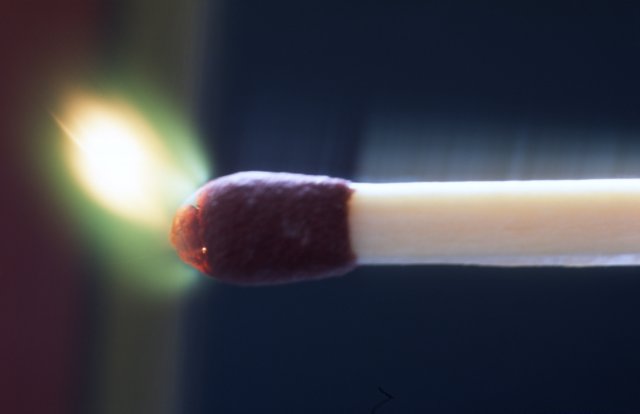 |
Gear, film and exposure: Shot with OM-4Ti + Zuiko 50/3.5 Macro + Bellows + Vari Magnifier + Motor Drive 1 + M. 18V Control Grip 1 + Relay Cord 1.2m + Black Backdrop + Wooden Boards + Table + 2 Glue Pliers. Film used: Fuji Provia 100F. At f22, shutter speed unrecorded.
Magnification: I recorded it, but I cannot find the notes anymore. Nonetheless, the matches used were the same ones as for the second match session, so when comparing these pictures, the second session pictures seem to have about 1.5 times the magnification of the first session pictures, so the magnification of the first session pictures must have roughly been 1.5 times (i.e. 1:1.5).
Subject information and technique: This was the first picture of the first session of match shots. This shot was taken during the daytime, without flash (it served as a test of the set-up so I could roughly determine what exposure times to expect during the night time shots). Funnily enough, on the left hand side one can see the match box I used to strike the match. Also, motion blur is obvious here, and the colours look weird (greenish).
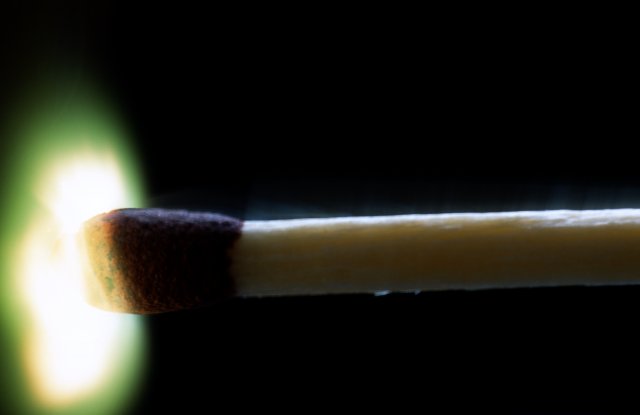 |
Gear, film and exposure: Shot with OM-4Ti + Zuiko 50/3.5 Macro + Circular Polariser + Bellows + Vari Magnifier + Motor Drive 1 + M. 18V Control Grip 1 + Relay Cord 1.2m + Black Backdrop + Wooden Boards + Table + 2 Glue Pliers. Film used: Fuji Provia 100F. At f22, shutter speed unrecorded, but it was several seconds.
Magnification: I recorded it, but I cannot find the notes anymore. Nonetheless, the matches used were the same ones as for the second match session, so when comparing these pictures, the second session pictures seem to have about 1.5 times the magnification of the first session pictures, so the magnification of the first session pictures must have roughly been 1.5 times (i.e. 1:1.5).
Subject information and technique: This picture was shot during night time, it is an Auot exposure and all light required for the exposure came from the match itself. This picture is better than the first one where motion blur is concerned, but the colours still look weird.
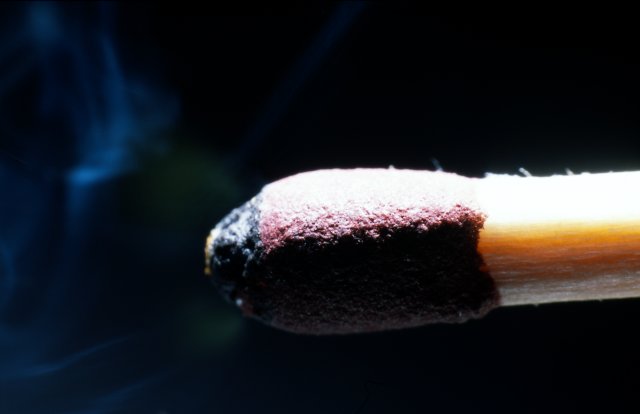 |
Gear, film and exposure: Shot with OM-4Ti + Zuiko 50/3.5 Macro + Bellows + Vari Magnifier + Motor Drive 1 + M. 18V Control Grip 1 + Relay Cord 1.2m + T28 Twin Flash + Manfrotto Tripod + Black Backdrop + 2 Bricks + Table. Film used: Fuji Provia 100F. At f16, shutter speed was 1/60th (flash synchronised).
Magnification: The magnification is the same as for the picture that appears in the gallery. The extension of the bellows was some 90 MM, and the lens extension was a further 25 MM. Added up, the total extension was then some 115 MM, which means a magnification of roughly 2.3 times (i.e. 1:2.3).
Subject information and technique: This was the first picture of the second session of match shots. This shot was taken during the daytime, with one flashhead firing from above. In this picture I triggered the camera a little bit too early.
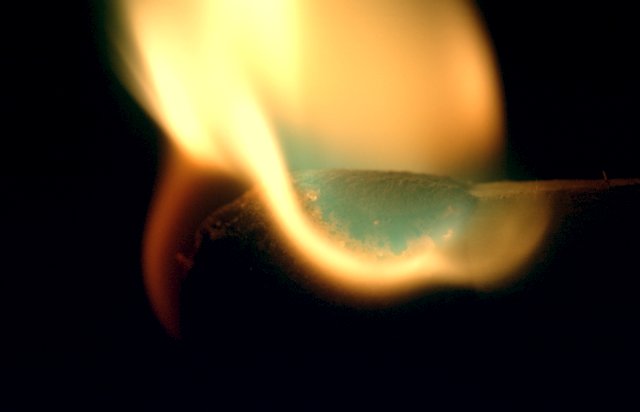 |
Gear, film and exposure: Shot with OM-4Ti + Zuiko 50/3.5 Macro + Bellows + Vari Magnifier + Motor Drive 1 + M. 18V Control Grip 1 + Relay Cord 1.2m + T28 Twin Flash + Manfrotto Tripod + Black Backdrop + 2 Bricks + Table. Film used: Fuji Provia 100F. At f16, shutter speed was 1/60th (flash synchronised).
Magnification: The magnification is the same as for the picture that appears in the gallery. The extension of the bellows was some 90 MM, and the lens extension was a further 25 MM. Added up, the total extension was then some 115 MM, which means a magnification of roughly 2.3 times (i.e. 1:2.3).
Subject information and technique: This was the third picture of the second session of match shots. This shot was taken during the daytime, with one flashhead firing from above. In this picture I triggered the camera a bit later than in the picture I selected for the gallery. The same digital manipulation of the colours as I applied to the shot in the gallery was necessary for this picture. In this picture the flame is properly exposed, but the rest is a bit underexposed.
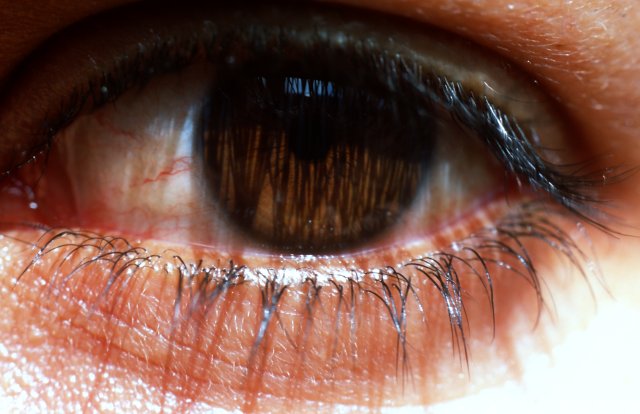 |
Gear, film and exposure: Shot with OM-4Ti + Zuiko 50/3.5 Macro + Hama 31mm Auto Extension Tube. Film used: Fuji Provia 100F. At f16, shutter speed was some 1/30th second.
Magnification: The extension tube measures 31 MM, and the lens extension was a further 25 MM. Added up, the total extension was then some 61 MM, which means a magnification of roughly 1.2 times (i.e. 1:1.2).
Subject information and technique: This picture was taken handheld and without flash. The reason for not using a flash was that I did not want to let my poor girlfriend be fired at with a flash from this close ;).
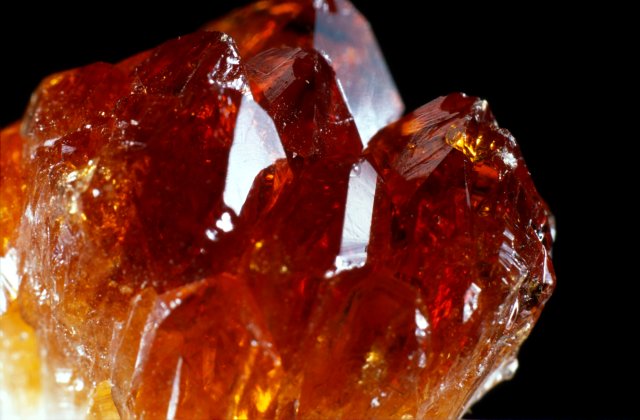 |
Gear, film and exposure: Shot with OM-4Ti + Zuiko 50/3.5 Macro + Bellows + Vari Magnifier + Motor Drive 1 + M. 18V Control Grip 1 + Relay Cord 1.2m + T28 Twin Flash Black + Black Backdrop + Table. Film used: Fuji Provia 100F. At f16, shutter speed was 1/60th (flash synchronised).
Magnification: The extension of the bellows was some 115 MM, and the lens extension was a further 25 MM. Added up, the total extension was then some 140 MM, which means a magnification of roughly 2.8 times (i.e. 1:2.8).
Subject information and technique: This is one of the first pictures of my back-up theme: my old stone collection. I thought it would be original to take some macro shots of semi precious stones, and this brown crystal looked very appealing to me. I am not quite certain anymore what type of crystal it is, but I believe it is Carneole (SP?).
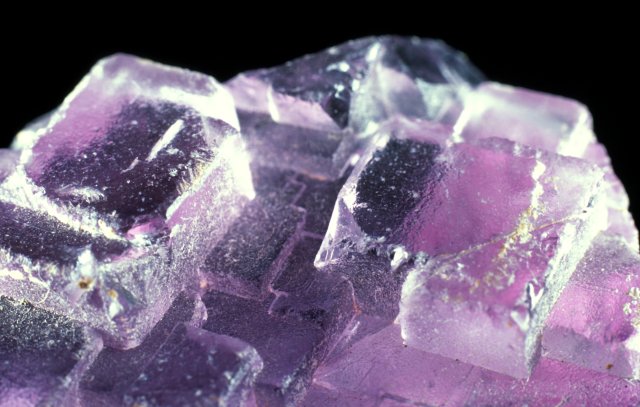 |
Gear, film and exposure: Shot with OM-4Ti + Zuiko 50/3.5 Macro + Bellows + Vari Magnifier + Motor Drive 1 + M. 18V Control Grip 1 + Relay Cord 1.2m + T28 Twin Flash Black + Black Backdrop + Table. Film used: Fuji Provia 100F. At f16, shutter speed was 1/60th (flash synchronised).
Magnification: The extension of the bellows was some 65 MM, and the lens extension was a further 25 MM. Added up, the total extension was then some 90 MM, which means a magnification of roughly 1.8 times (i.e. 1:1.8).
Subject information and technique: This is obviously a piece of Amethyst. The shape of the crystal is interesting, as it is the only cubic crystal shape Amethyst I have ever seen.
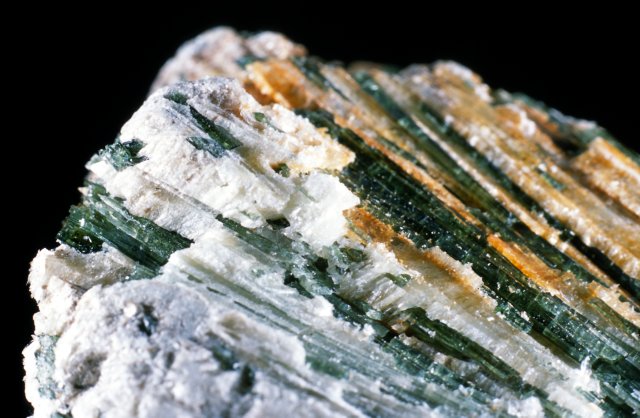 |
Gear, film and exposure: Shot with OM-4Ti + Zuiko 50/3.5 Macro + Bellows + Vari Magnifier + Motor Drive 1 + M. 18V Control Grip 1 + Relay Cord 1.2m + T28 Twin Flash Black + Black Backdrop + Table. Film used: Fuji Provia 100F. At f16, shutter speed was 1/60th (flash synchronised).
Magnification: The extension of the bellows was some 40 MM, and the lens extension was a further 25 MM. Added up, the total extension was then some 65 MM, which means a magnification of roughly 1.3 times (i.e. 1:1.3).
Subject information and technique: I am not certain anymore what the green crystals are, but I believe they are Hematite, perhaps someone can give a more conclusive answer?
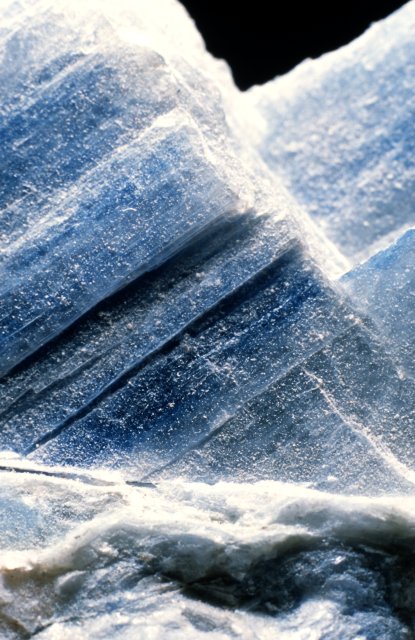 |
Gear, film and exposure: Shot with OM-4Ti + Zuiko 50/3.5 Macro + Bellows + Vari Magnifier + Motor Drive 1 + M. 18V Control Grip 1 + Relay Cord 1.2m + T28 Twin Flash Black + Black Backdrop + Table. Film used: Fuji Provia 100F. At f16, shutter speed was 1/60th (flash synchronised).
Magnification: The extension of the bellows was some 40 MM, and the lens extension was a further 25 MM. Added up, the total extension was then some 65 MM, which means a magnification of roughly 1.3 times (i.e. 1:1.3).
Subject information and technique: Another one of which I am not 100% certain anymore what it is. I believe that at the time I bought it, I was told it is some form of Cyan. Again, it would be great if someone could give a more conclusive answer.
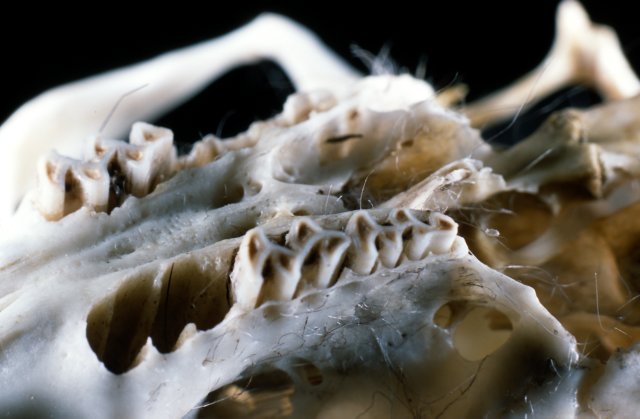 |
Gear, film and exposure: Shot with OM-4Ti + Zuiko 50/3.5 Macro + Bellows + Vari Magnifier + Motor Drive 1 + M. 18V Control Grip 1 + Relay Cord 1.2m + T28 Twin Flash Black + Black Backdrop + Table. Film used: Fuji Provia 100F. At f16, shutter speed was 1/60th (flash synchronised).
Magnification: The extension of the bellows was some 85 MM, and the lens extension was a further 25 MM. Added up, the total extension was then some 110 MM, which means a magnification of roughly 2.2 times (i.e. 1:2.2).
Subject information and technique: There is a very interesting story behind this skull, as it has undergone some owl-stomach-treatment. :) Indeed, this skull was retrieved by dissecting an owl fur ball. When I was a little boy I was an avid bird watcher, and on one occasion my father had discovered a group of owls in a nearby forest. I made several visits to the site and retrieved dozens of their fur balls. For a school project I dissected a lot of these fur balls and often one would find mice bones. This skull was miraculously well preserved (in all the other fur balls I dissected, the skulls were crushed and at best only jaws remained), and it is a bit bigger than the other skull parts I encountered. It looks like it came from either a rather big mouse, or from a small rat. The fur which can still be seen on the skull comes from the fur ball.
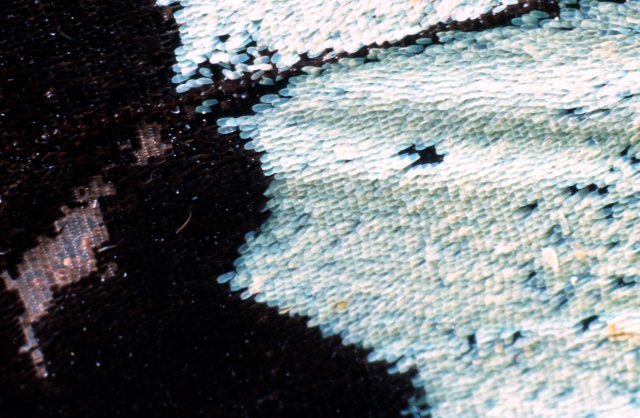 |
Gear, film and exposure: Shot with OM-4Ti + Zuiko 50/3.5 Macro + Bellows + Hama Auto Extension tubes: 13mm, 21mm, and 31mm + Vari Magnifier + Motor Drive 1 + M. 18V Control Grip 1 + Relay Cord 1.2m + T28 Twin Flash Black + Black Backdrop + Table + Slide Frame. Film used: Fuji Provia 100F. At f16, shutter speed unrecorded, but it was some 5 seconds.
Magnification: The extension of the bellows was some 200 MM, the total length of the three extension tubes was some 65 MM, and the lens extension was a further 25 MM. Added up, the total extension was then some 290 MM, which means a magnification of roughly 5.8 times (i.e. 1:5.8). Note: the lens was not reversed, perhaps I should have done that.
Subject information and technique: This picture shows a high magnification of a part of a butterfly wing. I racked out the bellows to its full extension and then added all three Hama Auto extension tubes to this set-up, giving an additional 65mm extension. The front of the lens was so far removed from the camera body that I could not use the T28 anymore, and as the front of the lens was also extremely close to the butterfly wing, I did not use a T32 with a TTL Cord, but rather I decided to just let the sun do the lighting (the sunrays came from the left hand side). The butterfly wing was attached to an opened slide frame so I could easily move it in front of the lens. The biggest problem after composing the picture (just imagine how shallow the DOF is at this much magnification!) was to prevent the wing from moving. I did not fully succeed in preventing the wing to move slightly in the wind, so I just took a lot of shots in the hope at least one of them would come out well. Most of the pictures came out surprisingly well, and this one was the best of them.
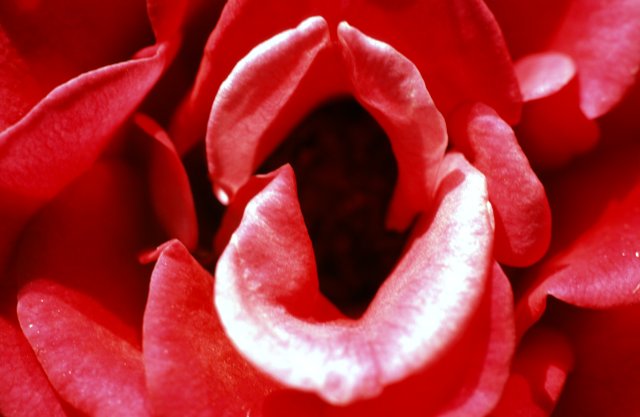 |
Gear, film and exposure: Shot with OM-4Ti + Zuiko 50/3.5 Macro + Hama 31mm Auto Extension Tube. Film used: Fuji Provia 100F. At f16, shutter speed was some 1/15th second (the picture was taken handheld).
Magnification: The extension tube measured 31 MM, and the lens extension was a further 25 MM. Added up, the total extension was then either some 56 MM, which means a magnification of roughly 1.1 times (i.e. 1:1.1).
Subject information and technique: Indeed, I did take one traditional flower macro shot too, but it was done with a special purpose: a list member showed me the interesting effect that's obtained by putting an ultra wide angle on a short extension tube and using that combination for macro photography. Such a demonstration can be seen in the next shot, and this picture serves for comparison purposes. The composition of this shot was inspired by a shot that appears in the Olympus Macrophotography Group Manual.
Note: it was not my intention to let this picture serve as a 1 on 1 comparison shot against the 24mm shot (otherwise I would have matched the magnification level), but rather to show some typical differences in the type of shots that can be obtained when using these lenses.
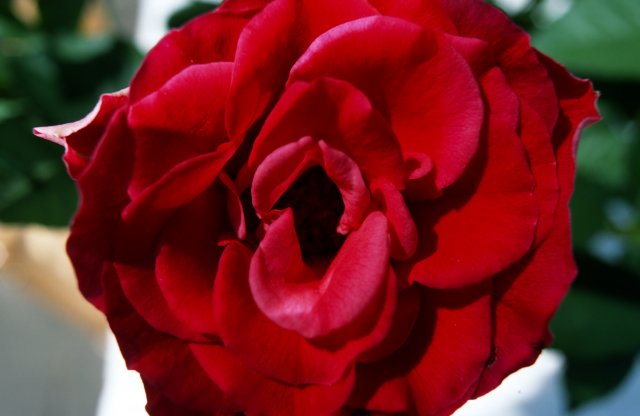 |
Gear, film and exposure: Shot with OM-4Ti + Zuiko 24/2.8 + Hama 13mm Auto Extension Tube. Film used: Fuji Provia 100F. At f16, shutter speed was some 1/15th second (the picture was taken handheld).
Magnification: The extension tube measured 13 MM, which means a magnification of roughly 0.5 times (i.e. 1:0.5).
Subject information and technique: As mentioned in the description of runner up nr. 12, this shot was taken using an ultra wide angle lens on a short extension tube (the shortest tube I have is the Hama 13mm one), to experiment a bit with the DOF and perspective this set-up offers. I think it gives a very nice effect, and it is really strange to see just how close one can bring the lens to the subject this way (in this picture the front of the lens almost touched the rose).